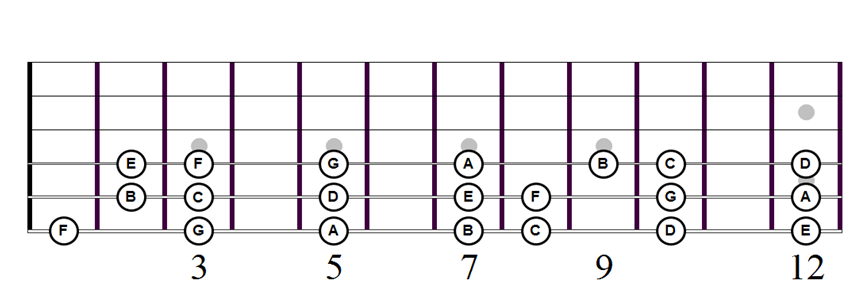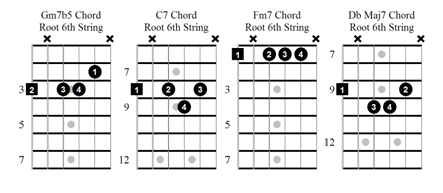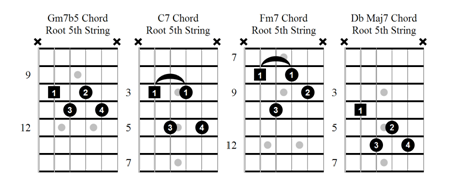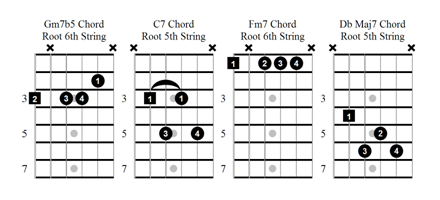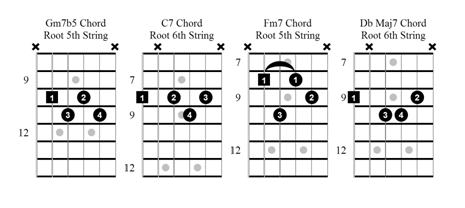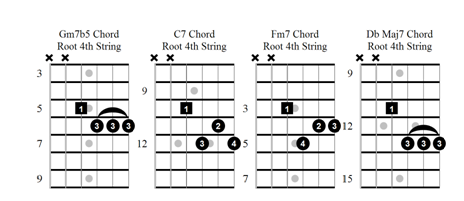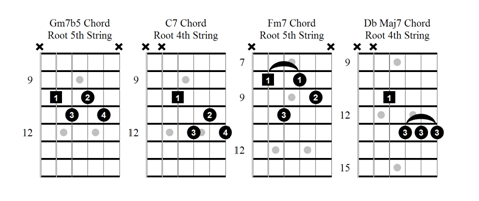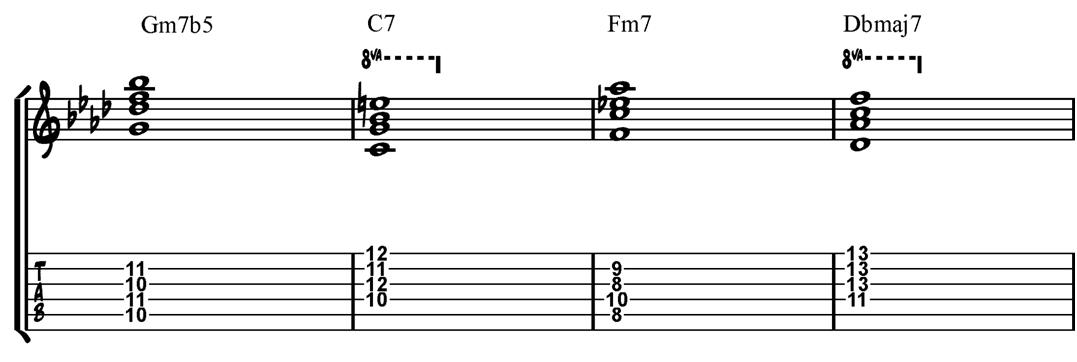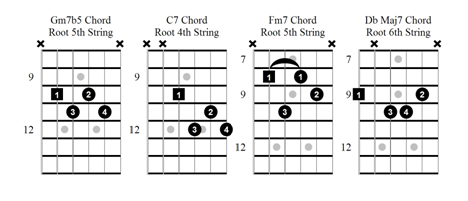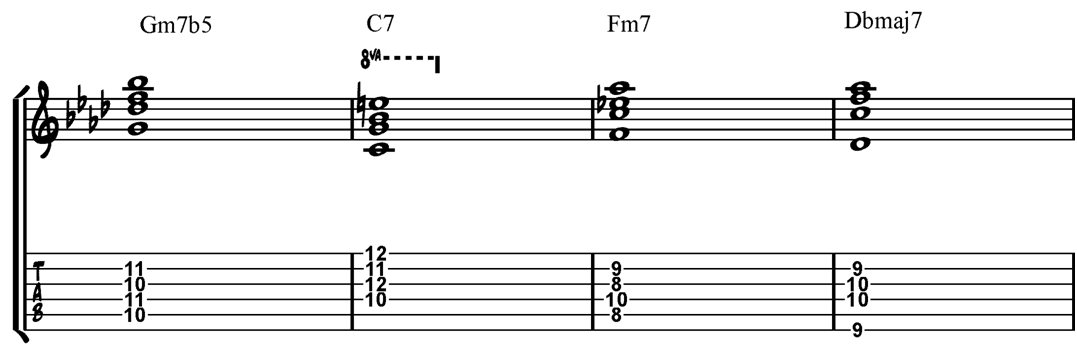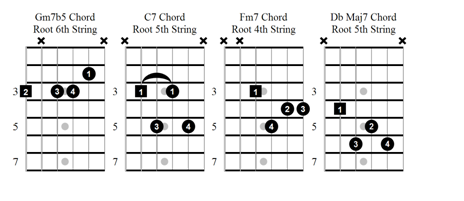Common Jazz Chord Voicings
In the previous Jazz Chord Voicings lesson, we learnt how the most common jazz chords are constructed. Now can begin to learn some useful voicings. The Jazz Guitar Chord Voicings in this lesson are designed to ‘get you through the tune’. They are the first jazz chord voicings that most guitarists learn, and will remain a part of your vocabulary from this point for-ward.
We will begin by learning three voicings of each of the fundamental chord types, maj7, 7, m7, and m7b5 and then apply them to a common jazz chord progression.
It is important at this point that you know where the notes are on your guitar fretboard as you will learn movable barre chord forms of each chord.
For example, we will learn a barre chord ‘7’ shape and if you want to play this chord as a C7 you will need to place it so that the root note is C. If you wish to play it as an F7 you will have to move it so that the root note is F. In order to do this you should at least be familiar with the notes on the bottom three strings:
We are going to learn to play the following chord progression using three different jazz chord voicings for each chord.
As you can see, this chord progression uses each of the chord types once.
Let’s begin by learning jazz chord voicings of these chords that have their root on the 6th string. The numbers written on the notes are suggested fingerings. If you find it easier to use different fingers then please feel free to use them.
You may find it easier to play the Fm7 chord ‘up an octave’ at the 13th fret, this is also fine.
Jazz Guitar Chord Voicings Example 2a:
Learn these jazz guitar chord voicingsand then join them together so you can play example 2a. Pay attention to the ‘X’s that show muted strings that don’t have a fretted note. You can mute them with the underside of the finger that is playing the fretted note on the lower string. For example, the open 5th string is muted by the finger playing the 6th string.
You will notice that these chord voicings move around a great deal on the fretboard. Don’t worry about this for now, as when you have a few more voicings under your fingers you can start to smooth out the movements.
Next, learn the same common chords voiced with the root on the 5th string:
Learn the same chord sequence using just the 5th string voicings:
Jazz Guitar Chord Voicings Example 2b:
Before moving on to learning these jazz guitar chord voicings types with a 4th string root, combine the 6th and 5th string chords to voice the chords closer together.
Try beginning on the 6th string for the Gm7b5 chord and then move to the closest voicing of the C7 chord on the 5th string (3rd fret) when you change. Always look for the closest pos-sible voicing when you change chords. One way of doing this could be:
Example 2c:
Another way to practice this is to begin on the 5th string voicing of the Gm7b5 chord and repeat the same process.
Example 2d:
By changing strings in this way, we can always create smoother ‘voice leading´ between each of the chords in the chord progression. (Voice leading is the technique of ar-ranging chords so that each note moves the smallest possible distance during each chord change). It is also easier to play these chords at speed because the fretting hand is not moving such great distances.
Now let’s look at how to play the same chords played with a 4th string root.
Try playing the same chord sequence just using these Jazz Guitar Chord Voicings. This ex-ample may be a little more difficult as you may not be as familiar with the note names on the 4th string as you are with the 5th and 6th strings. Take your time and persevere.
Example 2e:
As before, these chords jump up and down the neck a lot, so we can combine them with 5th string chords to make them flow more easily.
Try beginning the chord sequence on a 5th string Gm7b5 and then move to a 4th string C7.
Example 2f:
We could also change the Jazz Guitar Chord Voicings we use for the final Dbmaj7 in this sequence. If we play it as a 6th string root chord, the voicings will flow together more smoothly:
Example 2g:
Try starting the chord sequence on different strings and see how closely you can voicelead the chord progression. Here is just one possible ‘route’ through the changes starting on the 6th string:
Example 2h:
Now you are comfortable with the common voicings of these essential Jazz Guitar Chord Voicings, find as many ways as you can through the following chord progressions using the voicings discussed in this lesson:
Begin by playing through each progression using chords all with roots on the same string.
Next, combine the 6th and 5th string voicings.
When you are confident with 6th and 5th string voicings, combine the 4th and 5th string voicings.
Finally find the closest chord voicings using roots on all three strings.
In this lesson, you have learnt to combine the four most important types of chord in jazz in a common jazz chord progression. These chords are :
Major 7
Minor 7
Dominant 7
and
Minor 7b5 (m7b5)
By learning each root position chord in combination with other chords that are commonly played together, you’re not just learning ‘shapes’, you’re learning music.
These chord types can be used to get through 80% of all jazz tunes. They have been given in root position, in other words, they are played with the root (tonic) note played as the bass (lowest) note of the chord.
Later, when we study other types of voicings, you will see that it is not necessacery (and often not desirable) to play the root note in the bass, and we can create inversions of a chord by placing the 3rd, 5th or 7th note of the chord in the bass.
The best way to practice Jazz Guitar Chord Voicings is to apply them to real songs, and there are plenty of ways to do this.
If you’ve picked up this book, there’s a good chance you’re interested in lerning some jazz standards (early jazz songs) and it is easy to get a hold of some. The traditional way is to buy a “Real Book”, which is like a bible of jazz tunes. Each chord chart contains the melody (or head) and is written above the chords for the tune.
The Real Book is a big book and contains hundreds of tunes you’ll probably never learn fully, but are great to practice with. These hundreds of tunes contain multiple combinations of chords and sequences. You can open it on a random page and simple play through the chords in the song. You’ll start to recognise sequences that crop up time and time again ,and find new ways to navigate them on your guitar.
Playing through chord charts with a metronome is one of the best ways to learn to comp jazz chords. The metronome is important as you will learn to stay in time and play at a con-stant rate. If you make a mistake, don’t worry, just stay in time and get the next chord right. If there is a really difficult passage, switch the metronome off and plan your route through the chords.
While there are thousands of jazz songs, only around a few hundred are commnly known. Of those few hundred, most jazz players normally like to play only around 20 to 30 of their favourites.
These favorite songs are common at jazz jam nights and so it is wise to start your jazz play-ing career by learning the chords (and melody) to some of the most popular tunes.
Learning 20 or 30 songs is a big task but there is no hurry. Focus on learning one at a time and do everything you can to memorise it. This is a lot easier if you see it in terms of the four chord types given above.
Jazz standards are often grouped into tunes that have similar chord changes. For example, you might hear Autumn Leaves described as a “ii V I” tune because it contains lots of ii V I chord progressions.
Tunes like Anthropology and Oleo are grouped as “Rhythm Changes” tunes, beacause they are based on the changes to George Gershwin’s I Got Rhythm.
We will talk about different types of chord progression in the next lesson
It is useful to know what “type” of progression each standard is, as they are often used as workhourse tunes when learning to solo and there is a list of the most popular jazz stand-ards and their types of progression in the next lesson.
One tip; if you don’t want to buy a Real Book, is to do a Google image search for the title of the standard you want to learn, and add the word “chart”.
For more Jazz Guitar Chord Voicing lessons for beginners, check out my book The First 100 Jazz Chords for Guitar
“The artists you work with, and the quality of your work speaks for itself.”
Tommy Emmanuel
© Copyright Fundamental Changes Ltd 2024
No.6 The Pound, Ampney Crucis, England, GL7 5SA

